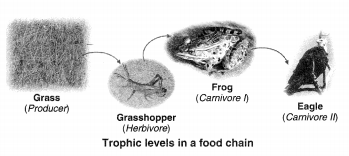In this NCERT Solutions for Class 10 Science Chapter 15 Our Environment – we discuss about how various components in the environment interact with each other and how it impact the environment. Students who are preparing for their Class 10 exams and searching for chapter-wise NCERT Solution for Class 10 Science must go through NCERT Solutions for Class 10 Science Chapter 15 Our Environment. Checkout previous chapter – NCERT Solutions for Class 10 Science Chapter 14 Source of Energy
ALSO CHECK – Download the free Class 10th Notes here
These NCERT Solutions for Class 10 Science Chapter 15 Our Environment is prepared by our best subject experts teachers group thats help students to understand all the topics easily. With the help of these NCERT Solution for Class 10 Science, students can understand the complex topics of class 10 science. We all know Science is a subject that needs a clear understanding of the concepts and topics to score well in it.
Also Check – NCERT Solutions for Class 9 Maths
NCERT Solutions for Class 10 Science Chapter 15 In-text Questions
Page No.- 260
Question 1
What are trophic levels ? Give an example of food chain and state the different trophic levels in it.
Answer:
Trophic Levels : The various steps in a food chain at which the transfer of food (or energy) takes place are called trophic levels.
Example : A food chain operating in a grassland is given below :
Grass → Insects → Frog → Birds
In this food chain
- Grass represents first trophic level.
- Grasshopper represents second trophic level.
- Frog represents third trophic level.
- Eagle represents fourth tropic level.
Question 2
What is the role of decomposers in the ecosystem ?
Answer:
- They act as a cleansing agent of the environment by decomposing the dead plants and animals
- They help in recycling the nutrients
- They provide space for new beings in the biosphere by decomposing the dead
- They help in putting back the various elements into water, soil and air for the reuse of producers like crop plants.
Page No.- 262
Question 1
Why are some substances biodegradable and some non-biodegradable ?
Answer:
Because the microorganisms like bacteria and decomposers like saprophytes have a specific role to play. They can breakdown only natural products like paper, wood, etc. but they cannot breakdown man-made products like plastics. Based on this, some substances are biodegradable and some non-biodegradable.
Question 2
Give any two ways in which biodegradable substances would affect the environment.
Answer:
(i) Biodegradable substances are decomposed by the action of microorganisms and decomposed materials are recycled through geo-chemical cycle.
(ii) These substances keep the environment clean.
Question 3
Give any two ways in which non-biodegradable substances would effect the environment.
Answer:
- They cause air, soil and water pollution.
- They may cause bio-magnification in the food chain resulting in the end of human.
Page No.- 264
Question 1
What is ozone and how does it affect any ecosystem ?
Answer:
Ozone is a molecule formed by the three atoms of oxygen and is known as an isotope of oxygen. The main function of ozone layer is to provide protection to the earth’s surface from the harmful UV rays of the sun. These rays are harmful to living organisms and may result in skin cancer.
Question 2
How can you help in reducing the problem of waste disposal ? Give any two methods.
Answer:
(i) Recycling : The solid wastes like paper, plastics and metals, etc. are recycled.
(ii) Preparation of Compost: Biodegradable domestic wastes such as left over food, fruit and vegetable peels and leaves of potted plants, etc. can be converted into compost by burying in a pit dug into ground.
NCERT Solutions for Class 10 Science Chapter 15 Exercise Questions
Page No.- 264
Question 1
Which of the following groups contain only biodegradable item ?
(a) Grass, flowers and leather
(b) Grass, wood and plastic
(c) Fruit peels, cake and lime juice
(d) Cake, wood and grass
Answer:
(a) Grass, flowers and leather.
Question 2
Which of the following constitutes a food-chain ?
(a) Grass, wheat and mango
(b) Grass, goat and human
(c) Goat, cow and elephant
(d) Grass, fish and goat
Answer:
(b) Grass, goat and human.
Question 3
Which of the following are environment friendly practices ?
(a) Carrying cloth-bags to put purchases in while shopping
(b) Switching off unnecessary lights and fans
(c) Walking to school instead of getting your mother to drop on her scooter
(d) All of the above
Answer:
(d) All of the above.
Question 4
What will happen if we kill all the organisms in one trophic level ?
Answer:
If we kill all the organisms in one trophic level, the food supply to the next level will strop resulting in imbalance of the ecosystem. As a result animals in the higher levels will die making the growth of animals in the lower trophic level increase in an enormous way. All of this will affect the overall balance in the ecosystem.
Question 5
Will the impact of removing all the organisms in a trophic level be different for different trophic levels ? Can the organisms of any trophic level be removed without causing any damage to the ecosystem ?
Answer:
Yes, the impact of removing all the organisms in a trophic level will be different for different trophic levels. For example, on removing producers; herbivores would not be able to survive or they would migrate and ecosystem would collapse. If herbivores are removed, producers would grow unchecked and carnivores would not get food. If carnivores are removed, herbivores would increase to unsustainable levels and could destroy the producers. If decomposers are removed, the dead animals would pile up due to which the environment would become polluted. In addition to this, if dead animals will not decompose, the recycling of nutrients in the soil will be stopped and its fertility will be reduced. As a result the green cover of the earth will be lost. Thus to maintain the balance of the ecosystem the presence of organisms is necessary at each trophic level.
Question 6
What is biological magnification ? Will the levels of this magnification be different at different levels of the ecosystem ?
Answer:
Biological magnification : Biological magnification can be defined as the progressive increase in the concentration of non-biodegradable wastes in the food chain.
As there is an increase in the magnification at the successive trophic levels of the ecosystems, all the other levels do get affected and the concentration may vary when compared to first level.
Question 7
What are the problems caused by the non-biodegradable wastes that we generate ?
Answer:
The problems caused by the non-biodegradable wastes are :
- If the quantity of non-biodegradable matter increases in the nature then bio-magnification of poisonous chemicals in our body increases.
- If the non-biodegradal waste keeps on increasing there will not be left any substance for new organisms.
- The increasing quantity of non-biodegradable waste will cause imbalance of ecosystem.
Question 8
If all the waste we generate is biodegradable, will this have no impact on the environment ? [CBSE 2011, 2013]
Answer:
Biodegradable wastes are decomposed by the microorganisms into simpler substances which can be used by the producers as a raw material. But if it is not disposed off properly, it will affect the environment adversely.
- As the decomposition of the biodegradable wastes are slow, they produce an awful smell and when inhaled by humans it can be harmful.
- The dumping areas can be a place where harmful organisms may start to breed which can be harmful to humans as well as plants and animals.
- Increase in the number of aquatic organisms may result in depletion of oxygen.
Question 9
Why is damage to the ozone layer a cause for concern ? What steps are being taken to limit this damage ?
Answer:
The damage to the ozone layer is a cause for concern because, The ozone layer is a protective cover for the earth. It prevents harmful UV rays from entering the earth as these rays harmful and can result in skin cancer. Too much of UV rays are harmful to plants as they affect photosynthesis, destroy planktons and decomposers.
if the ozone layer in the atmosphere disappears completely, then all the extremely harmful ultraviolet radiations coming from the sun would reach the earth. These ultraviolet radiations would cause skin cancer and other ailments in men and animals and also damage the plants.
Steps taken to limit this is that many developing and developed countries have signed and are obeying the directions of UNEP (United Nations Environment Programme) to freeze or limit the production and usage of CFCs.







